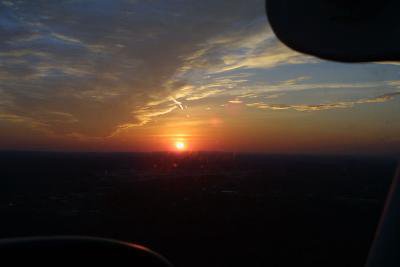Night Skies
Yesterday's flight was one of the most enjoyable and challenging in a while. My school's night check-out had lapsed so I went out with my instructor friend to get signed off for another year. This is not an FAA required flight, but rather a policy at my FBO to ensure that you are competent and safe for night flying.
We took off close to 7 p.m. in somewhat turbulent but crystal clear skies and headed south. I'd planned to make an occasion of the check-out and add a night time tour of Boston to it, which would also be a memorable experience for Jen and my stepdaughter Emily. After calling Boston Approach we were cleared into Bravo airspace below 2,000 from the West, so we followed the Mass. Pike and reached the city in no time flat thanks to a healthy tail wind.
From our vantage point at 1,500 ft, the city, shining with a million lights, stood majestically out of the darkness of the harbor. While we maintained proper separation from the city, we could almost see through the buildings' windows and enjoyed spying the flurry of activity (read mind-boggling traffic) in the city center's congested and winding streets. We circled downtown from the south soon finding ourselves on what looked like a long final to runway 4R at Logan. Sticking their noses in strong southwesterly winds, a perfectly aligned stack of airliners flew toward us in the distance and in a perfect aerial ballet skillfully coordinated by the good people at Boston Approach touched down gracefully on 22L.
As we turned west to loop around the North End, the city lights projected faded orange spots on the edge of the water below us and the Custom House never looked quite so stunning. A minute later we followed the Charles River over the Zakim Bridge, which stood out with its modern design and pleasing blue lighting. Soon, we reached Fenway Park, which while empty was flooded with white lights. I made a steepish turn over it to prolong our view, which turned out to be good practice since strong winds forced me to pull out my rusty ground reference maneuver skills.
Approach kindly allowed us to make a second orbit around the city before we left their airspace and headed back for a few stop and go's, of which the FAA requires three in the last 90 days in order to be current to carry passengers at night.
I followed the Mass. Pike out of town, overflew my friend's house (where his wife, whom he had called beforehand, flashed the houselights on and off as we passed overhead) and soon prepared to enter the pattern at Hanscom.
"Report midfield left downwind for 23," came from the controller.
I'd spotted the beacon and was now trying to figure out which ones of these myriad lights delineated the dimly lit runway 23. It took me a while as I wrestled to keep the plane upright as we hit a few moderate bumps, but I finally did it. While very familiar with the area, it looked almost foreign at night.
It was a great reminder of just how different flying at night is. As a passenger on an airliner, with all the time to focus outside the window, I'd never have a problem spotting a landmark at night. But in turbulent skies, as I kept glancing back and forth between the panel to check my altitude and speed and outside to find the runway and spot traffic, it's quite a bit of work and can be disorienting. I was actually frustrated by my initial confusion and still am. Lesson: in spite of familiarity with an area I will from now on have an airport diagram handy to help me figure out the field's layout relative to the beacon.
Now on final for my first night landing in many many months, I wondered how I'd do. The physics, of course, are the same as during the daytime. But a runway at night can play tricks on you and typically a pilot will feel that he his flying higher than he really is, making it easy for an inexperienced night pilot as myself to make a hard, flat landing.
Yet, the first touchdown was soft and spot on the centerline in spite of howling winds.
I stopped the plane and went around the pattern twice more, with much more ease finding my bearings. My final two landings of the night were good, somewhat soothing the frustration about my amateurish entry to the traffic pattern earlier.
Night flying, while spectacular, is a different animal to your normal day VFR outings. It can be conducted very safely but as with anything else in aviation, great respect and humility on the part of the pilot is necessary. While I have no problems carrying passengers in the daytime, I plan on getting sharper at night on my own before I take anyone with me. I've had a couple of nice solo flights at night back when my skills in the dark skies weren't as rusty and it will probably take another two or three outings alone or with an instructor before my comfort level and abilities get back up to where I want them in order to feel safe flying other people around.
So here I am, sitting at my desk with a view on the Charles, longingly eyeing that little corner of the sky where I flew last night. Wish I was there again now.
I'll tell you one thing: My office looks a lot better from up there.



0 Comments:
Post a Comment
<< Home